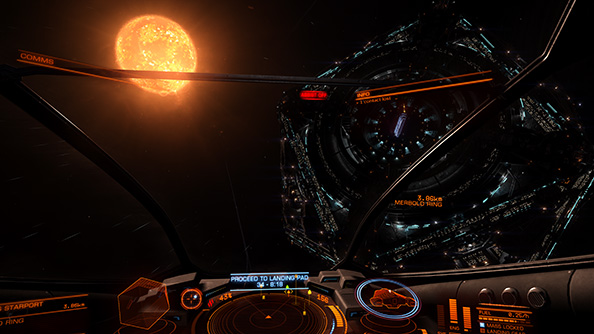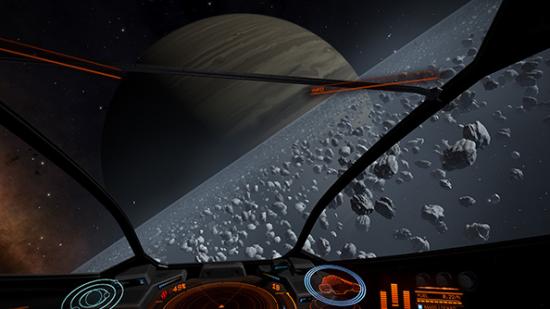Elite: Dangerous is a game about space.
In it, you take on the role of a space captain in charge of a space ship. You’ve got 1,000 space moneys and all of space to explore. Will you make your fortune shooting bad space men? Or will you carve out an income shooting space rocks? Perhaps you’ll find riches in trading rare space goods. Or maybe you’ll explore the farthest depths of space itself, discovering valuable and highly sought after information on the topic of “what exactly is space”.
Elite: Dangerous is a giant spacey sandbox. The game’s playing area encompasses the entirety of our galaxy, every star and planet and nebula and moon that we know about, plus billions of procedurally generated ones on top. You’re bolted into the cockpit of the game’s most basic runaround ship, the Sidewinder, and then effectively left to your own devices. What you do first is entirely up to you. There are three competencies to rank up in: exploration, combat and trading, and so if Elite: Dangerous has any goal to speak of, it is simply to prosper in this universe as best you can within these parameters.
The simulation of space is beautifully realistic in some aspects and then unashamedly compromised in others. For example, there’s loads of space. Every celestial body in Elite: Dangerous is the correct physical distance apart, so flying from planet to planet within a system requires travelling at superluminal speeds for several minutes per jaunt, as your destination grows from pale blue dot to screen-filling gas giant, or twinkling star to roaring ball of hot plasma inferno. Travelling feels significant when just getting somewhere takes this long.
Moving through systems in Elite: Dangerous leaves you slightly in awe of the scope and scale of the worlds you’re travelling between, a feat that’s helped along by a creaking, groaning soundscape of rocketing frameshift drives and churning space engines. Your ears will believe you’re in a battered old boat that’s breaking several laws of physics just to deliver a load of vegetables to the next star. Visually too, the fidelity and detail and slickness of the most basic actions in Elite: Dangerous totally sell the idea of space travel. It’s fun to fly around.

Physics takes a bit of a break when it comes to how ships behave themselves in regular flight however. Spaceships in Elite: Dangerous fly like planes, using constant thrust to propel themselves around, and pitching and yawing with fixed turning speeds. A joystick, or at least a analogue stick, is pretty much essential. And while you can happily mosey along between planets at hundreds of times the speed of light, while under normal propulsion you have a top speed of just a few hundred metres per second, enough to have Newton spinning in his grave (with perfect rotational velocity around his corpse’s exact centre of mass, knowing that guy).
But these curious spaceflight physics result in much more interesting combat, transforming long-range jousting battles into intimate and intense dogfights in which you must out-turn and out-maneuver your opponent, cartwheeling and spiralling through space like WW2 fighter aces. Your ship’s capabilities matter so much more when one craft can be more nimble than another, and the deliberately wrongwise physics ultimately creates the cornerstone of Elite: Dangerous’s most developed career path: attacking and destroying other ships to make explosions in space.
Besides, everybody knows Newtonian physics is for nerds.

All around the galaxy and dotted throughout the various star systems are a handful of different kinds of space station. It’s here that you find bulletin boards that generate a number of different kinds of mission. These range from the straightforward, such as delivering an amount of cargo to a destination, to the more dangerous and involved, such as hunting down an NPC in space using their last known location.
At release, there aren’t many of these missions to be found. You’ll see them repeated from the outset with a few of the words swapped around. And invariably, while en route to carry out a mission objective, you’ll encounter an NPC who’ll suggest an alternative outcome. Deliver the cargo to another location for a greater reward. Call off your hunt in exchange for a smaller payout. You soon see all of the procedurally generated strings on this space bow.
That’s not to say that accepting and completing these missions isn’t rewarding. Early in the game, the grind to accrue enough credits to upgrade from your basic Sidewinder is absolutely compelling. Purchasing your first new ship and looking around its novel and shiny interior is thrilling, as is hearing the all-new engine noises the thing makes. Meanwhile, increasing your cargo space to haul more stuff feels like worthwhile progress to a trading-brained pilot, and putting more guns on will make any player feel happier too. The slow loop of saving and upgrading your ship is a gratifying one.

Progress plateaus after a few dozen hours however, and depending on your style of play Elite: Dangerous can become about as tedious as hauling cargo between rocks in space should rightly be. No matter which of the viable career paths you choose – trading, mining, exploring, shooting good guys, shooting bad guys – they scarcely change or evolve as you better equip yourself to carry them out. You’ll be accepting the same missions in a bigger or more gun-addled ship, and earning the same credits with more zeroes on the end.
Even exploration yields diminishing returns as you drop out of hyperspace again and again to find the same handful of star types resting in a slightly different configuration to the ones you just left behind. After a while you no longer feel like you’re traversing the void like an interstellar Francis Drake, rather that you’re stuck inside a solar system that’s been set to shuffle.
All of this repetition and grind as you fling yourself through space is speckled by (in the more dangerous systems at least) encounters with pirates, as well as the odd random “unidentified signal source” found hanging in space. But even these begin to repeat, revealing themselves to only ever be a handful of scripted kinds of encounter. Sometimes you’ll find a trader, other times it will be random cargo, or some NPC ships inexplicably pootling about in the middle of nowhere. And to arrive at these random signals takes up so much precious time, often whole minutes of just pointing your crosshairs at the signal and sitting on the brakes.

Far, far too much of the Elite: Dangerous experience involves staring at a destination as it approaches with aching slowness. And too much involves discovering you’ve wasted your time doing so. Too rarely are you rewarded for taking these detours, and too often is the greatest reward in Elite: Dangerous simply that the game hasn’t wasted your time any more than it needed to.
There are other systems and set pieces here, redeeming ones. Battles involving dozens of individual NPCs and capital ships are spectacular to behold, and the combat AI in these situations is smart enough to avoid piling on to you unfairly. You can single out the enemy ships you know you can handle and tackle those guys, avoiding the larger baddies with the scarier guns to some extent.
Combat is absolutely where Elite: Dangerous shines, and it’s in outfitting your ship with new guns and missiles and shootybangs that most players will find the most rewarding and consistent progress. Through combat you’ll also see the faction system at its most relevant. In communal scraps you’re asked to pick a side, with each small victory over an opponent tipping the balance of power one way or the other. Ostensibly this (alongside who you choose to trade for and sell to) powers some of the player-driven, emergent goings-on in Elite: Dangerous, though so far it’s a seemingly subtle effect that impacts little on your activities.

Though now officially released, Elite: Dangerous still feels half-baked in many regards. It’s multiplayer only, though it lacks the ability to team up and stick together, to share bounties or even to send cash. Instead the benefits of being online are largely limited to the occasional sight of another player flying into the side of a space station. Frontier still haven’t added all of the planned ships either, though the fifteen that are currently here are sumptuously detailed things, from their individually riveted cockpit panels to the unique whirring of their little thrusters. And as for planned features such as planetary landings, well, that might be a while coming.
If the developer can continue updating at the pace they managed leading up to launch however, Elite: Dangerous will be transformed in a year’s time. But they’ll have a huge job bringing personality and humanity to their universe. You know how in the Pixar film Cars, there are buildings and cities and roads, but no humans? Well, imagine that, but with fewer cars and the cars don’t talk, and the cars look sad, and it’s always dark. That’s how lonely Elite: Dangerous feels at the moment.
But it’s beautiful, and the very simple joy of flying through it can’t be denied, and should probably be experienced by everybody. And the game’s sound design alone needs to be held up as an industry standard to any other developers hoping to lasso a player’s consciousness like a big sexy audio cowboy. It’s the best sounding game that has ever been.
Elite: Dangerous is a beautiful arcade experience, plugged into an empty galaxy, one so big and bold that it might trick you into thinking there’s more to see and do than there really is. You’ll probably love it anyway.
